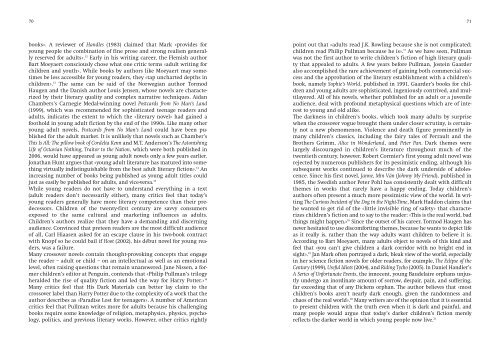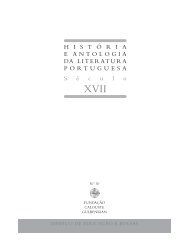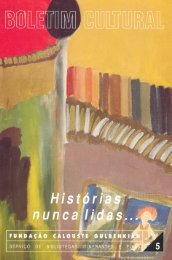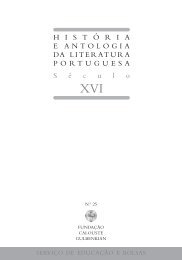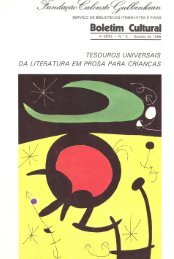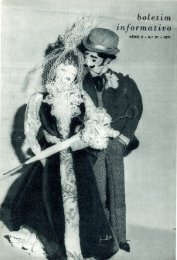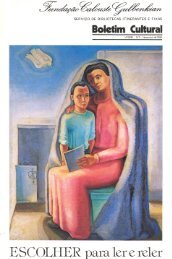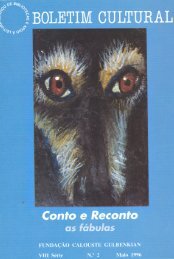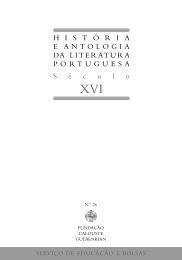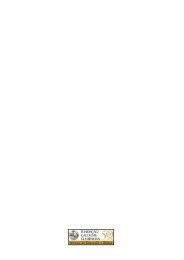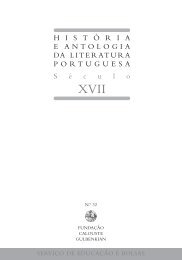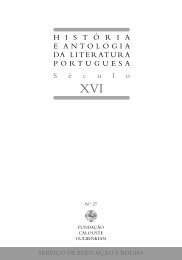Formar Leitores para Ler o Mundo - Leitura Gulbenkian - Fundação ...
Formar Leitores para Ler o Mundo - Leitura Gulbenkian - Fundação ...
Formar Leitores para Ler o Mundo - Leitura Gulbenkian - Fundação ...
You also want an ePaper? Increase the reach of your titles
YUMPU automatically turns print PDFs into web optimized ePapers that Google loves.
70<br />
books». A reviewer of Handles (1983) claimed that Mark «provides for<br />
young people the combination of fine prose and strong realism generally<br />
reserved for adults». 12 Early in his writing career, the Flemish author<br />
Bart Moeyaert consciously chose what one critic terms «adult writing for<br />
children and youth». While books by authors like Moeyaert may sometimes<br />
be less accessible for young readers, they «tap uncharted depths in<br />
children». 13 The same can be said of the Norwegian author Tormod<br />
Haugen and the Danish author Louis Jensen, whose novels are characterized<br />
by their literary quality and complex narrative techniques. Aidan<br />
Chambers’s Carnegie Medal-winning novel Postcards from No Man’s Land<br />
(1999), which was recommended for sophisticated teenage readers and<br />
adults, indicates the extent to which the «literary novel» had gained a<br />
foothold in young adult fiction by the end of the 1990s. Like many other<br />
young adult novels, Postcards from No Man’s Land could have been published<br />
for the adult market. It is unlikely that novels such as Chamber’s<br />
This Is All: The pillow book of Cordelia Kenn and M.T. Anderson’s The Astonishing<br />
Life of Octavian Nothing, Traitor to the Nation, which were both published in<br />
2006, would have appeared as young adult novels only a few years earlier.<br />
Jonathan Hunt argues that «young adult literature has matured into something<br />
virtually indistinguishable from the best adult literary fiction». 14 An<br />
increasing number of books being published as young adult titles could<br />
just as easily be published for adults, and vice-versa. 15<br />
While young readers do not have to understand everything in a text<br />
(adult readers don’t necessarily either), many critics feel that today’s<br />
young readers generally have more literary competence than their predecessors.<br />
Children of the twenty-first century are savvy consumers<br />
exposed to the same cultural and marketing influences as adults.<br />
Children’s authors realize that they have a demanding and discerning<br />
audience. Convinced that preteen readers are the most difficult audience<br />
of all, Carl Hiaasen asked for an escape clause in his two-book contract<br />
with Knopf so he could bail if Hoot (2002), his début novel for young readers,<br />
was a failure.<br />
Many crossover novels contain thought-provoking concepts that engage<br />
the reader – adult or child – on an intellectual as well as an emotional<br />
level, often raising questions that remain unanswered. Jane Nissen, a former<br />
children’s editor at Penguin, contends that «Philip Pullman’s trilogy<br />
heralded the rise of quality fiction and led the way for Harry Potter.» 16<br />
Many critics feel that His Dark Materials can better lay claim to the<br />
crossover label than Harry Potter due to the complexity of a work that the<br />
author describes as «Paradise Lost for teenagers». A number of American<br />
critics feel that Pullman writes more for adults because his challenging<br />
books require some knowledge of religion, metaphysics, physics, psychology,<br />
politics, and previous literary works. However, other critics rightly<br />
point out that «adults read J.K. Rowling because she is not complicated;<br />
children read Philip Pullman because he is». 17 As we have seen, Pullman<br />
was not the first author to write children’s fiction of high literary quality<br />
that appealed to adults. A few years before Pullman, Jostein Gaarder<br />
also accomplished the rare achievement of gaining both commercial success<br />
and the approbation of the literary establishment with a children’s<br />
book, namely Sophie’s World, published in 1991. Gaarder’s books for children<br />
and young adults are sophisticated, ingeniously contrived, and multilayered.<br />
All of his novels, whether published for an adult or a juvenile<br />
audience, deal with profound metaphysical questions which are of interest<br />
to young and old alike.<br />
The darkness in children’s books, which took many adults by surprise<br />
when the crossover vogue brought them under closer scrutiny, is certainly<br />
not a new phenomenon. Violence and death figure prominently in<br />
many children’s classics, including the fairy tales of Perrault and the<br />
Brothers Grimm, Alice in Wonderland, and Peter Pan. Dark themes were<br />
largely discouraged in children’s literature throughout much of the<br />
twentieth century, however. Robert Cormier’s first young adult novel was<br />
rejected by numerous publishers for its pessimistic ending, although his<br />
subsequent works continued to describe the dark underside of adolescence.<br />
Since his first novel, Janne, Min Vän (Johnny My Friend), published in<br />
1985, the Swedish author Peter Pohl has consistently dealt with difficult<br />
themes in works that rarely have a happy ending. Today children’s<br />
authors often present a much more pessimistic view of the world. In writing<br />
The Curious Incident of the Dog in the Night-Time, Mark Haddon claims that<br />
he wanted to get rid of the «little invisible ring of safety» that characterizes<br />
children’s fiction and to say to the reader: «This is the real world, bad<br />
things might happen.» 18 Since the outset of his career, Tormod Haugen has<br />
never hesitated to use discomforting themes, because he wants to depict life<br />
as it really is, rather than the way adults want children to believe it is.<br />
According to Bart Moeyaert, many adults object to novels of this kind and<br />
feel that «you can’t give children a dark corridor with no bright end in<br />
sight». 19 Jan Mark often portrayed a dark, bleak view of the world, especially<br />
in her science fiction novels for older readers, for example, The Eclipse of the<br />
Century (1999), Useful Idiots (2004), and Riding Tycho (2005). In Daniel Handler’s<br />
A Series of Unfortunate Events, the innocent, young Baudelaire orphans unjustly<br />
undergo an inordinate amount of sorrow, despair, pain, and suffering,<br />
far exceeding that of any Dickens orphan. The author believes that «most<br />
children’s books aren’t nearly dark enough, given the randomness and<br />
chaos of the real world». 20 Many writers are of the opinion that it is essential<br />
to present children with the truth even when it is dark and painful, and<br />
many people would argue that today’s darker children’s fiction merely<br />
reflects the darker world in which young people now live. 21<br />
71


